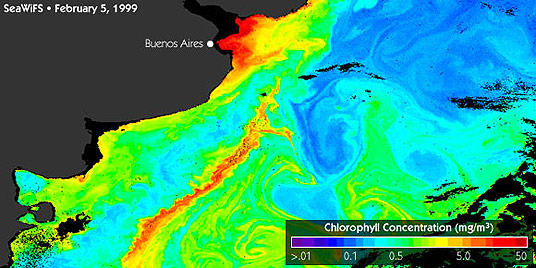More Upwelling - the Southern Ocean and elsewhere
Upwelling in the Southern Ocean
In recent years scientists have started to realize that the Southern Ocean plays a very important role in the mixing of surface and deep waters. Large-scale upwelling is common there, where strong eastward winds blow around Antarctica all year round.
These winds drive a significant flow of water northwards from the coast of Antarctica, as in the coastal upwelling mechanism for the Southern hemisphere, and the surface water is replaced by water drawn up from great depths. In this region however the growth of phytoplankton may be limited by the availability of light: normally light is only sufficient for the phytoplankton to bloom in the austral summer.
Other causes of upwelling
Eddies
Eddies can also upwell nutrient-rich water when they form and move across the ocean. It is normally those eddies that show a negative sea surface height (SSH) signature (i.e. a depression at the surface, also corresponding to water colder than the surrounding areas) that are responsible for upwelling, while those with a positive SSH (warm eddies) have the opposite effect, i.e. they downwell warm surface waters.
The net impact of eddies (and other propagating features in the ocean, such as Rossby waves) on phytoplankton growth in the global ocean is not yet completely understood, and is a subject of very active research by many oceanographers.
Current interactions
Finally, upwelling may also happen where two currents interact. A case in point is the area off the coasts of Brazil and Argentina in the Southwestern Atlantic Ocean. There, the interaction between the warm, poleward flowing Brazil Current and the cold, equatorward flowing Malvinas Current (an offshoot of the Antarctic Circumpolar Current) causes some dramatic phytoplankton blooms.
Brazil/malvinas current upwelling - seen from space

